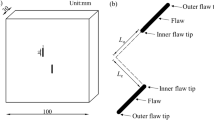Abstract
One problem encountered when determining the effective mechanical properties of large-scale objects, which requires calculating their strength in processes of mechanical interaction with other objects, is related to the possible variability in their local properties including those due to the action of external physical factors. Such problems comprise the determination of the effective strength of bodies one of whose dimensions (thickness) is significantly less than the others and whose properties and/or composition can vary with the thickness. A method for estimating the effective strength of such bodies is proposed and illustrated with example of ice cover strength under longitudinal compression with regard to a partial loss of the ice bearing capacity in deformation. The role of failure localization processes is shown. It is demonstrated that the proposed approach can be used in other problems of fracture mechanics.
Similar content being viewed by others
References
G. W. Timko and R. M. W. Frederking, “Compressive Strength of Ice Sheets,” Cold Reg. Sci. Techn. 17, 227–240 (1990).
V. P. Afanasiev and V. N. Smirnov, “Methods for Calculating the Full-Scale Strength of Ice,” Aktual. Probl. Sovrem. Nauki, No. 6, 244–248 (2010).
E. M. Schulson, “The Brittle Compressive Fracture of Ice,” ActaMetal.Mater. 38 (10), 1963–1976 (1990).
R. V. Gol’dshtein and N. M. Osipenko, “Some aspects of strength in sea ice mechanic,” Fiz. Mezomekh. 17 (6), 59–69 (2014) [Phys.Mesomech. (Engl. Transl.) 18 (2), 139–148 (2015)].
A. S. Vavakin and R. L. Salganik, “On Effective Characteristics of Inhomogeneous Media with Isolated Inhomogeneities,” Izv. Akad. Nauk SSSR. Mekh. Tverd. Tela, No. 3, 65–75 (1975) [Mech. Solids (Engl. Transl.)].
V. V. Bogorodskii and V. P. Gavrilo, Ice (Gidrometeoizdat, Leningrad, 1980) [in Russian].
G. F. N. Cox and W. F. Weeks, “Profile Properties of Undeformed First-Year Sea Ice,” in CRREL Report 88–13 (Hanover, New Hampshire, 1988).
S. K. Singh and I. J. Jordaan, “Constitutive Behavior of Crushed Ice,” Int. J. Fract. 97, 171–187 (1999).
B. Haimson and H. Lee, “Borehole Breakouts and Compaction Bands in Two High-Porosity Sandstones,” Int. J. Rock.Mech. Min. Sci. 41, 287–301 (2004).
P. N. Mollema and M. A. Antonellini, “Compaction Bands: A Structural Analog for Antimode I Crack in Aeolian Sandstone,” Tectonophys. 267, 209–228 (1996).
G. P. Cherepanov, Mechanics of Brittle Failure (Nauka, Moscow, 1974) [in Russian].
B. Haimson, “Borehole Breakouts in Berea Sandstone Reveal a New Fracture,” Pure Appl. Geophys. 160, 813–831 (2003).
R. V. Gol’dshtein and N. M. Osipenko, “Fracture Structures in Intensive Compression,” in Problems of Mechanics of Deformable Solids and Rocks (Fizmatilit, Moscow, 2006), pp. 152–166. [in Russian].
J. P. Dempsey, A. C. Palmer, and D. S. Sodhi, “High Pressure Zone Formation during Compressive Ice Failure,” Engng Fract. Mech. 68, 1961–1974 (2001).
R. V. Gol’dshtein and N. M. Osipenko, “On an Ice Failure Model with a Large Contact Region,” Izv. Ross. Akad. Nauk. Mekh. Tverd. Tela, No. 1, 137–153 (2011) [Mech. Solids (Engl. Transl.) 46 (1), 109–122 (2011)].
R. V. Gol’dshtein and N. M. Osipenko, “Ice Failure Mechanics and Its Applications,” Vestnik Novosib. Univ. Ser. Mat. Mekh. Inform., No. 4, 42–48 (2012).
R. V. Gol’dshtein and N. M. Osipenko, “Melting Localization Model under Conditions Corresponding to the Lithosphere and Upper Mantle Interface,” in Actual Problems of Mechanics (Nauka, Moscow, 2009), pp. 439–455 [in Russian].
D. M. Cole, “The Microstructure of Ice and Its Influence on Mechanical Properties,” Engng Fract. Mech, 68, 1797–1822 (2001).
K. Hellan, Introduction to Fracture Mechanics (McGraw-Hill, New York, 1984; Mir, Moscow, 1988).
Y. Murakami (Editor), Stress Intensity Factors Handbook (Pergamon Press, Oxford, 1987; Mir, Moscow, 1990).
I. J. Jordan, “Mechanics of Ice Structure Interaction,” Engng Fract. Mech. 68, 1923–1960 (2001).
D. Sodhi, “Ice Structure Interaction with Segmented Indenters,” in Proc. of IAHR Ice Symposium, Banff, Canada (1992), pp. 909–929.
V. M. Finkel, V. A. Fedorov, and A. P. Korolev, Crystal Fracture in Mechanical Twinning (Sev.-Kavk. Nauch. Tsentr Vyssh. Sh., Izdat. Rostov Univ., Rostov-on-Don, 1990) [in Russian].
V. M. Finkel, “On Specific Characteristics of Steel Fracture in Quenching and the Possibilities of Channel Formation in It,” Fiz. Mezomekh. 9 (4), 31–48 (2006).
Author information
Authors and Affiliations
Corresponding author
Additional information
Original Russian Text © R.V. Goldstein, N.M. Osipenko, 2017, published in Izvestiya Akademii Nauk, Mekhanika Tverdogo Tela, 2017, No. 4, pp. 80–93.
About this article
Cite this article
Goldstein, R.V., Osipenko, N.M. Estimates of the effective compressive strength. Mech. Solids 52, 417–428 (2017). https://doi.org/10.3103/S0025654417040082
Received:
Published:
Issue Date:
DOI: https://doi.org/10.3103/S0025654417040082




